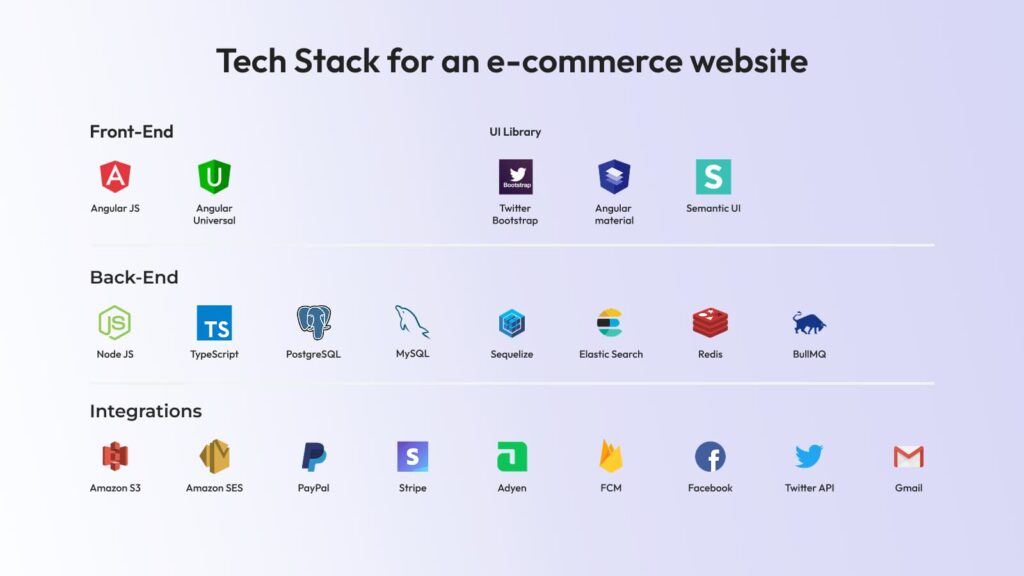Of all the Internet businesses, E-commerce Websites are the most dominant. Expenses of creating such a website may differ based on the extent of its individuality, the number of options, and technical requirements.
This post highlights these aspects, presents an average estimate, contrasts the custom and the ready-made templates, and stresses the need for investing in quality e-commerce websites. Each of these has to be understood by any investor who would wish to undertake informed actions in the creation or re-creation of any business.
Factors Influencing Ecommerce Website Cost
There are some of factors that one has to be conversant with while doing the budgeting and making the right decisions.
Complexity of Design
As compared to the templates, designing a perfect, unique, and sophisticated layout that suits your brand absolutely needs much time and appropriate skills, and this might lead to high costs. The resulting design represents a more costly proposal the more detailed and unique the product design is.
Functionality and Features
These are elementary features, without which one cannot survive, for example, product categorization, cart functionality, and payments. However, on top of these, implementing more sophisticated features and functions like the personalization of recommendations, or the application of the live chat and inventory control shall increase the costs. Whereas in the case of functionalities all the more complicated the functionalities are the higher the development cost will be.
When planning such functionality, it’s also important to choose the right tech stack for ecommerce website development — from frameworks like React or Angular on the frontend to Node.js, PHP, or Python on the backend, combined with scalable cloud hosting and secure payment integrations.

Platform
The costs incurred also depend on the usage of different platforms such as; Shopify, Woo-commerce, or even Magento too. Some of the platforms are very much expensive and they charge high licensing fee. Some of them may not provide the maximum extent of scalability and could need addition customization and even development perhaps from your side.
Level of Customization
While having a custom-made website has its benefits of being more flexible and easily scalable, you should know that they will be more expensive. Although this means that one can tailor functionalities based on the requirements that the individual has, it also entails time in development and has skills that are specialized.
At Cleveroad, we’ve helped businesses of different sizes navigate the challenges of ecommerce website development by balancing design complexity, feature scope, and platform choice. Our experience covers projects built on Shopify, Magento, WooCommerce, as well as fully custom solutions: so we know how to optimize ecommerce website cost without compromising scalability or user experience. With a proven track record in creating tailored online stores, Cleveroad can guide you in choosing the right approach and tech stack to ensure your project delivers long-term value.
Mobile Responsiveness
Make sure that the website looks good and works well in the best-case medium, which is the mobile. The cost will rise if the design is to be developed with every available device giving out the same user-interface look.
SEO and Marketing
SEO components and marketing tools can be integrated into the website during its development phase, and this means that your Website is already optimized for promotion. It will lead to high start-up costs as compared to the long-term gains including high traffic and visibility.
Security Measures
It must be of considerable importance that there are measures to safeguard customer information as well as for secure buying. These include SSL certificates, payment gateways that have secure layers of protection, and abiding the rules such as GDPR even though it may lead to added expenses, but for trust as well as legal requirements.
Support and Maintenance
Other services such as post-launch support and maintenance determine a smooth and secure website operations which affect the overall and possibly the long-term budget. From these analyses, the considerations you make will place you in the right vicinity of the numbers for creating an e-commerce site that functions properly to generate revenue for your company and to allow clients to feel like they have had a positive shopping experience.
Average Build Cost of Ecommerce Websites
The actual cost of developing an ecommerce website depends on the site’s complexity and features. But here is a general idea of what the costs look like on average:
Basic Ecommerce Website
Cost Range: $3,000 – $10,000
Ideal for small businesses or startups with templates—features: product listings, shopping carts, basic SEO, and standard payment gateways included. Some variations available in design.
Intermediate Ecommerce Website
Cost: $10,000 – $50,000
An ideal fit for growing businesses requiring more website personalization and advanced functionalities, like custom designing, enhanced UX, third-party integrations, greater security, and profound SEO.
Advanced Ecommerce Website
Cost Range: $50,000 – $200,000+
Perfect for large enterprises looking for high levels of customization and advanced features like unique design, advanced analytics, complex integrations, personalized experiences, and robust security.
Ecommerce Website for Enterprise Level
Cost Range: $200,000+
For the big guns in business, having huge catalogs and huge traffic, doing this with custom features, top security, complete integration with enterprise systems, and custom functionalities. Now, these cost ranges help you to budget correctly and set expectations for your ecommerce website project.
Custom or Ready-Made Site?
This choice is crucial for estimating the cost of the project and its functionality:. Here’s a quick comparison:
Custom Ecommerce Site
Pros:
- Unique design: Will give you a look that is completely yours
- Scalability: Handle growth and expanding product catalogs
- Full control: freedom to add or adjust features
- Advanced functionality: customized features according to business requirements
Cons:
- Expensive: $10,000 to $200,000+
- More time in development: mostly some months’ period
- Maintenance: ongoing budget and expertise.
Readymade E-commerce Site
Pros:
- Cost: Normally ranges between $3,000 and $10,000 for basic setup
- Deployable in less time: Setup within weeks
- User-friendly: Easy to use and manage
- Support and updates by the platform provider
Cons:
- Restrictive customizations — have restrictions on design and features.
- Scalability problems — may not handle huge growth
- Platform dependency — relies on the provider for upgrades
Which one to go for
Startups/Small Business: Lower costs; thus, ready-made solutions with quick setups.
Growing/Established Businesses: The site should be scalable and the brand should remain unique through the site at a relatively high cost.
Your budget, timeline, and business needs will dictate how to approach building a marketplace website for e-commerce.
Why You Should Invest in an E-commerce Website
No other strategic investment could ever be important for any business looking for growth in reach and sales, apart from investing in an e-commerce website. Here’s why:
More Sales and Revenue
An ecommerce website turns your business open to the global market; hence you can sell products at any time of the day. This type of incessant availability assures many more sales and, in the event, much higher revenue.
Superior Customer Experience
An e-commerce site can provide a rich shopping experience by way of easy navigation, personalized recommendations, and convenient payment options. This enhances customers’ satisfaction and makes them more loyal. Customers will have repeated transactions in your store and give the company positive reviews.
Reduced Operational Costs
Online stores are in many cases cheaper to operate than a physical store. You save on rent, utilities, and in-store staffing expenses. Besides, automation in inventory management as well as in processing of orders lowers human errors and in this way it saves you much in terms of labor costs.
Robust Analytics
Ecommerce platforms come with solid analytics that provide details on customer behaviors, sales trends, and the effectiveness of marketing. These analytics may offer the required information to make choices, optimize your marketing strategy, and improve your product offerings.
Competitive Advantage
A well-designed ecommerce site will give you a strong competitive edge. It provides an opportunity to communicate your brand’s unique value proposition, offer exclusive online promotions, and adapt quickly to market changes.
Scalability
An e-commerce site scales up very easily along with your business; more products, more traffic, addition of more features—it’s able to accommodate all those things. It allows for longer-term growth without heavy reinvestment in a new infrastructure.
Market Expansion
E-commerce puts the customer at your hands’ reach even if they are not within your geographical zone, tapping into markets within the nation and internationally. A larger market could realize substantial growth and diversity in your customer pool.
E-commerce website development isn’t merely about making your presence felt online; it’s the heart of a high-growth sales channel with an improved customer experience that could bring you the insights you need for continued improvement.
Cost of E-commerce Website Varies with Features
The cost of an e-commerce website varies based on features. Here is a quick breakdown:
- The base features to at least include product listing, shopping cart, and checkout range from $5000 to $15,000.
- Advanced Product Features: Advanced search and enhanced product displays might fall in the bracket of $2,000 to $10,000.
- Mobile Optimization: Optimizing website behavior on mobile devices would cost between $1,000 and $5,000.
- Custom Design: Designing a very professional site for branding purposes would normally cost around $3,000 to $15,000 more.
- Third-Party Integrations: Any kind of integration with CRM or marketing tools could be approximately within the range of $1,000 to $5,000.
- CMS: Custom CMS may cost an additional $2,000 to $7,000.
- Added security features: These can add $500 to $3,000.
- Regular maintenance: From $500 to $2,000 annually.
Realizing these costs will enable you to budget accordingly and be able to prioritize features.
Conclusion
An e-commerce website is one of the strategic investments for any business that desires to thrive in the online marketplace. It could be expensive depending on the design, functions, and platform adopted. Therefore, here they are: the researched elements of cost in the article, average price ranges, and comparison of a custom vs ready-made. A high-quality e-commerce website is an investment, to improve customer experience, increase sales, and remain competitive. So, with these costs in the back of your head and careful budgetary planning, you can make fully informed choices and build a successful online presence that will serve the goals of your business.


